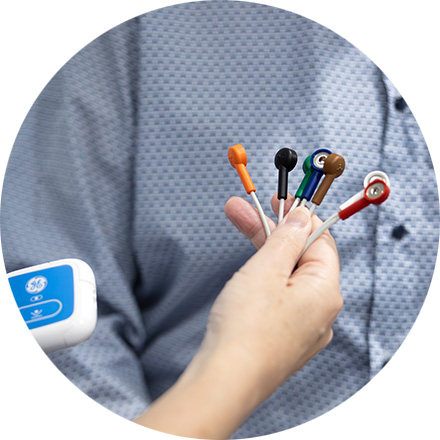Holter (24hr ECG monitoring)
A holter monitor is a small battery powered device, which continuously records heart activity for 24-48hrs. The holter monitor is a continuous testing device, which picks up heart rate and rhythm and will also record irregular heart beats (arrhythmias). The device is attached by electrodes to your chest to monitor heart function on a longer-term basis than that of a quick ECG.
You should allow 20 minutes for the electrode placement to be undertaken and explanations given on how to use this device and remove at the end of the 24hrs.

Before your procedure:
- Take your usual medications.
- Wear a two piece outfit on the day so you can easily undress to your waist and the electrodes can be fitted.
- Three of the electrodes are fitted under your neckline – so if you feel slightly conspicuous with the monitor we suggest you wear a shirt/top with a high(ish) but loose neckline.
The Nurse or Cardiac Technician will explain the procedure to you, how to use the ‘event’ button and how to stop the holter device and remove all the equipment from your chest at the end of the 24hrs.
To prepare your skin they may need to shave your chest (gentlemen). Once the skin is prepped sufficiently they will attach 7 ECG dots to your chest. These ECG dots will then connect to leads that are attached to a holter monitor.
The device will capture your heart rate and rhythm for 24hrs. The device can either be attached to your waist band, belt or put on a lanyard around your neck.
Whilst wearing this device you are unable to get wet. Unfortunately this means you are unable to shower, bath or go swimming until the device, ECG dots and leads have been removed.
You will be requested to keep a holter diary of any activities you undertake or events that have occurred to provide the cardiac scientists reviewing the data, with extra information.
You can stop the device at the specified time and take off the ECG leads and equipment as shown to you by the Nurse/Technician.
Return the holter and all equipment to our reception staff and it will be analysed. A follow up appointment with your cardiologist is usually undertaken a week later for the results. A report will be sent to your GP/Referrer.
